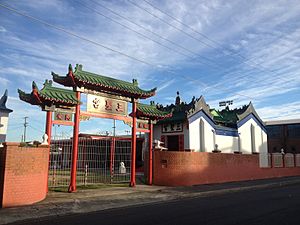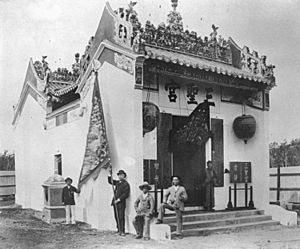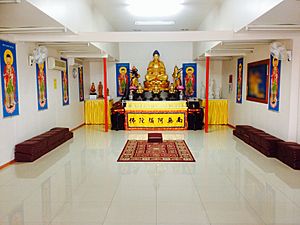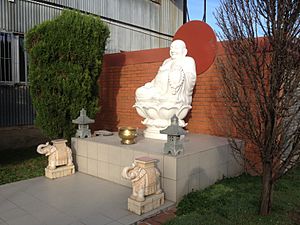Holy Triad Temple, Albion facts for kids
Quick facts for kids Holy Triad Temple, Albion |
|
|---|---|

Holy Triad Temple, Albion, 2014
|
|
| Location | 32 Higgs Street, Albion, City of Brisbane, Queensland, Australia |
| Design period | 1870s - 1890s (late 19th century) |
| Built | 1885 - 1886 |
| Official name: The Holy Triad Temple, Breakfast Creek Joss House, Sarm Sung Goon | |
| Type | state heritage (built) |
| Designated | 21 October 1992 |
| Reference no. | 600056 |
| Significant period | 1885-1886 (fabric) |
| Significant components | gate - entrance, statue, wall/s, furniture/fittings |
| Lua error in Module:Location_map at line 420: attempt to index field 'wikibase' (a nil value). | |
The Holy Triad Temple is a special old building in Albion, Brisbane, Australia. It was built a long time ago, between 1885 and 1886. This temple is also known as the Breakfast Creek Joss House or Sarm Sung Goon. It's a very important place because it shows the history of Chinese people in Queensland. Because of its importance, it was added to the Queensland Heritage Register in 1992.
A Look Back: The Temple's Story
The Holy Triad Temple was built for the Cantonese Chinese community in Brisbane. This happened between 1885 and 1886.
In the 1880s, many Cantonese people came to Brisbane. They often ran small businesses, especially in areas like Fortitude Valley. Many also worked as market gardeners. They grew fresh vegetables around places like Breakfast Creek and Eagle Farm. By 1888, Chinese gardeners supplied almost all of Brisbane's fresh vegetables.
The leaders of Brisbane's five Cantonese families wanted to create a central place for their community. So, they decided to build this temple. The beautiful triple roof was brought all the way from China. It was imported by a big Chinese trading company in Brisbane called Quong Nam Tai & Co. Chinese builders then put the temple together.
The temple officially opened on January 21, 1886. For almost 60 years, it was the main gathering place for the Chinese community in Brisbane. Over time, fewer people used it, and it became a bit neglected. But in 1965, a group called the Chinese Temple Society was formed.
This society worked hard to fix up the temple. It was reopened in June 1966. Today, the temple continues to be an important place for different Chinese communities in Brisbane.
In the late 1800s, Chinese immigrants built temples in many places in Queensland. These included goldfields and port cities. Only three of these old temples are still standing today. They are the Breakfast Creek temple, the small Chun Lo Goon temple in Rockhampton, and the Hou Wang Temple in Atherton. The Atherton temple is smaller and was built using local materials.
What the Temple Looks Like
The temple is a rectangular building made of brick with a smooth, plastered finish. It has a special triple roof made of Chinese terracotta tiles. A really cool part of this roof is its amazing decoration. It has detailed ceramic figures of Chinese historical and mythical characters. These figures are found on the roof's ridges and along the edges.
Inside, the temple has three main parts. First, there's an entrance area. Next, there's a middle section that gets light from above, like a skylight. Finally, there's the main temple area. This part has a beautifully carved altar. On the altar, you can see figures of the gods of wealth, medicine, and knowledge.
The inside of the temple is very fancy. It has carved wooden supports that are covered in gold, a process called gilding. You can also see beautiful silks, embroidered fabrics, lanterns, and lamps.
During the 1965-1966 restoration, the middle part of the roof, which had been taken off, was put back. Many of the original decorations inside had been saved or damaged. These were carefully replaced during the restoration.
Today, the temple is located on a quiet back street. It is surrounded by the Breakfast Creek Hotel, the Albion Park Racecourse, and some light industrial buildings. The old view across Breakfast Creek is no longer there. A simple concrete block building has been built next to the temple. The temple grounds are now covered in concrete and surrounded by a brick fence with a gate.
Why the Temple is Important
The Holy Triad Temple was added to the Queensland Heritage Register on October 21, 1992. It met several important requirements to be listed.
The temple shows how Queensland's history developed. The Holy Triad Temple is important because it shows how Chinese communities grew in Brisbane during the 1800s.
The temple is a rare example of Queensland's cultural heritage. The Holy Triad Temple is special because it is one of the few Chinese temples from the 1800s that still exists in Queensland.
The temple shows the main features of its type of cultural place. The Holy Triad Temple is important because it is a great example of a Chinese temple built in the 1800s in Queensland.





